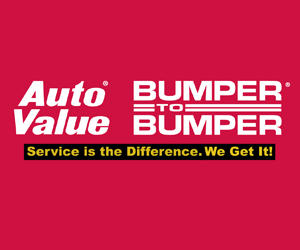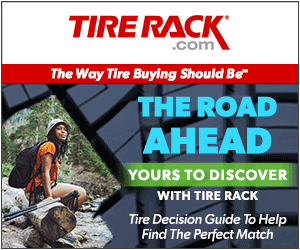2017 Cadillac XT5
Cadillac is as guilty as anybody for kicking off the large luxury SUV craze. Remember the first 1999 Escalade? Yet, Cadillac was slow to follow the market shift to luxury crossovers. So, even though their mid-size SRX is top seller for the brand, it lacks the wide spread critical praise of their cars. So, let’s see if that changes as Caddy’s reboots their crossover strategy with the all-new XT5.
Although on an all-new chassis, don’t think of the 2017 Cadillac XT5 as an all-new concept. Rather, it’s a continuation of what the SRX started; luxurious, tech-savvy transportation for 5, but this time with driving dynamics that more closely match their key German and Asian rivals.
Whether you’re a fan of the Crossover Touring re-naming strategy or not, hopefully Cadillac will stay consistent with it; as they expand from this midsize XT5 to, perhaps, a 3-row XT7, and compact XT3.
As for the XT5, it wears a face that’s a taller version of Caddy’s new flagship CT6 sedan. Both head and tail lighting have vertical orientation.
There’s less departure along the rest of the exterior, where some shades of SRX and even Chevrolet Equinox remain in profile and in the rear. Our Red Passion Tintcoated Luxury model had excellent paint quality.
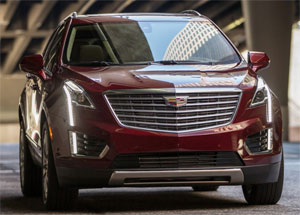 Compared to the SRX, there are 2-inches of added wheelbase; yet overall length is almost an inch shorter. It is also slightly taller and narrower. Standard wheels are 18s; 20s are optional.
Compared to the SRX, there are 2-inches of added wheelbase; yet overall length is almost an inch shorter. It is also slightly taller and narrower. Standard wheels are 18s; 20s are optional.
But, driving is where you notice the biggest XT to SRX changes. Street and highway ride and handling are clearly not old-school Caddy. It’s decidedly European, even borderline stiff; yet compliant enough to eagerly soak up bumps softly. Following a recent and welcomed GM trend, close to 300-lbs. has been shaved and you feel the added responsiveness at every turn of the nicely weighted electric steering.
There’s no Euro-style turbo-4 power under the hood however, at least here in the U.S.; as Caddy’s LGX version of GM’s 3.6-liter V6 is the only choice.
And it’s a very decent one, delivering 310-horsepower and 271 lb-ft. of torque seamlessly; working well with the standard 8-speed automatic transmission. They make a good combo as long you’re not looking for an all-out performance ute.
Front-drive is standard, with a new twin-clutch all-wheel-drive system optional. It can send full power front or rear, as well as left or right at the rear axle. Slippery roads are its forte, but we found this flexible setup to be a welcomed aid in dry handling as well. Or, switch it off for best fuel economy.
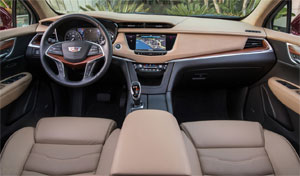 Inside, is a clean, simple, attractive design very similar to flagship CT6; with no shortage of tech and luxury touches. Trim, whether traditional wood or sportier bright-work, is exceptional.
Inside, is a clean, simple, attractive design very similar to flagship CT6; with no shortage of tech and luxury touches. Trim, whether traditional wood or sportier bright-work, is exceptional.
You can chose from quite a few light or dark themes, our favorite being the classy Jet Black. And there’s much small item storage space around.
But we have to subtract a few points after dealing with the latest CUE infotainment system. It is fully compatible with Apple CarPlay and Android Auto and we love that. But after a long day of getting frustrated with the gesture controls, we could think of only one final gesture to give it. Caddy please give us a knob or two!
The gauge panel is not quite as tech-heavy as CT6, but still a nice info-heavy array, with the now-expected reconfigurable setup.
The front seats look great but need work. We found them hard, yet still lacking in all-day support.
Thanks to the extra wheelbase, the rear seat provides great leg room; not always a high point of this class. It slides and reclines too. Still head room can be tight thanks to an intrusive panoramic glass roof.
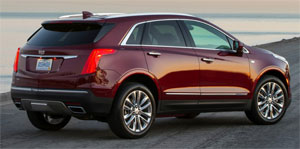 E-shifters are “en vogue” these days, and Caddy’s has logical and precise movement. A backup camera is standard, the CT6’s Rear Camera Mirror, and a full suite of active safety features are optional.
E-shifters are “en vogue” these days, and Caddy’s has logical and precise movement. A backup camera is standard, the CT6’s Rear Camera Mirror, and a full suite of active safety features are optional.
Rear seat up cargo capacity is good at 30.0 cu.-ft. Fold the 40/20/40 seatbacks to expand it to 63.0 cu.-ft. A cargo management system is available. Maximum trailer tow is the expected 3,500-lbs.
Government Fuel Economy Ratings for front-wheel-drive are 19-City, 27-Highway, and 22-Combined. For an average Energy Impact Score of 15.0-barrels of annual oil consumption and 6.5-tons of CO2 emissions.
XT5 base pricing is $39,990 for front-wheel drive. All-wheel-drive can be added to mid-level trims for $2,495 more, but it comes standard with the $63,495 top-level Platinum.
The 2017 Cadillac XT5 will have a hard time standing out in the crowded luxury crossover segment. But truth be told, the retiring SRX actually did quite well with what it had, and we think the XT5 will do even better. It provides more luxury, more tech, and yes, a much more satisfying driving experience. It should appeal equally to both long-time and first-time luxury buyers, and bodes well for a future full lineup of crossover Cadillacs.
Specifications
- Engine: 3.6 liter
- Horsepower: 310
- Torque: 271 lb-ft.
- EPA: 19 mpg city/ 27 mpg highway
- Energy Impact: 15.0 barrels of oil/yr
- CO2 Emissions: 6.5 tons/yr
2024 Honda Ridgeline TrailSport
It Does Truck-Like Things Better Than Ever
Honda brought something truly unique to the pickup truck scene when their mid-size Ridgeline debuted for 2006. In 2017, it moved towards becoming a little more true truck-like, both in form and capability, now with yet another step in that direction for 2024. So, let’s see if the Ridgeline is really hitting its stride.
For 2024, it’s all about making this Honda Ridgeline better than ever. There are styling tweaks outside, along with tech and functional improvements inside, but the biggest news is the Ridgeline has now joined Honda’s TrailSport family of off-road inspired vehicles. This more-true-trucklike, second-gen Ridgeline been around since 2017, receiving periodic updates over the years; but joining the TrailSport family is the biggest leap yet.
Primarily, the TrailSport transformation includes General Grabber all-terrain tires, mounted on new Pewter Gray 18-inch wheels, steel underbody protection, and retuning the strut front, and multi-link rear suspension for added wheel articulation. And while we always appreciate the additional traction of off-road tires, the Ridgeline’s standard i-VTM4 all-wheel drive, with Intelligent Traction Management and snow, sand, and mud settings, was already quite capable of handling all but the most extreme off-roading, ground clearance of just 7.6 inches being it’s only real hinderance.
A 3.5-liter V6 remains under the hood as it has since the Ridgeline debuted for 2006; the current version outputs 280 horsepower and 262 lb-ft of torque, plenty enough muscle to handle its 5,000-lbs. towing capacity. A nine-speed automatic transmission with paddle shifters and bevy of push and pull buttons on the console replaced the six-speed automatic back in 2020.
In addition to adding TrailSport capability, a big focus for this update was making it more user-friendly inside, starting with the central touchscreen growing from 8 to 9 inches. It also gets faster processing speeds, menus have been simplified, and the native navigation system is improved with better graphics. It’s accompanied by a new digital instrument cluster, along with an upgraded center console with more storage space. Unique TrailSport touches include heavy duty floormats, leather-trimmed seats, orange stitching throughout the cabin, and orange ambient lighting.
The Ridgeline continues to offer things available nowhere else in the pickup truck market.
Exterior styling doesn’t exactly shout “macho big rig coming your way,” but the more vertical face and larger grille that arrived for 2021, along with this year’s added TrailSport elements, do continue to toughen up the Ridgeline’s image. The 5’4” bed remains highly functional with no large wheel well intrusions, multiple tie-downs points, lighting and even speakers. And of course, the Ridgeline continues to offer things available nowhere else in the pickup truck market, like the dual-action tailgate, and large, lockable, drainable, underbed storage. Not to mention being able to drive around in true car-like comfort, something we took full advantage of on our way to our Mason Dixon Dragway test track.
There was great grip off the line, with full power arriving smoothly but quickly, helping us to get to 60 in 7.0 seconds flat, a tenth quicker than the last Ridgeline we tested. That power delivery stayed fairly consistent the whole way down the track, barely interrupted by the nine-speed automatic’s smooth shifting. Our best quarter-mile run was 15.5 seconds at 90 mph.
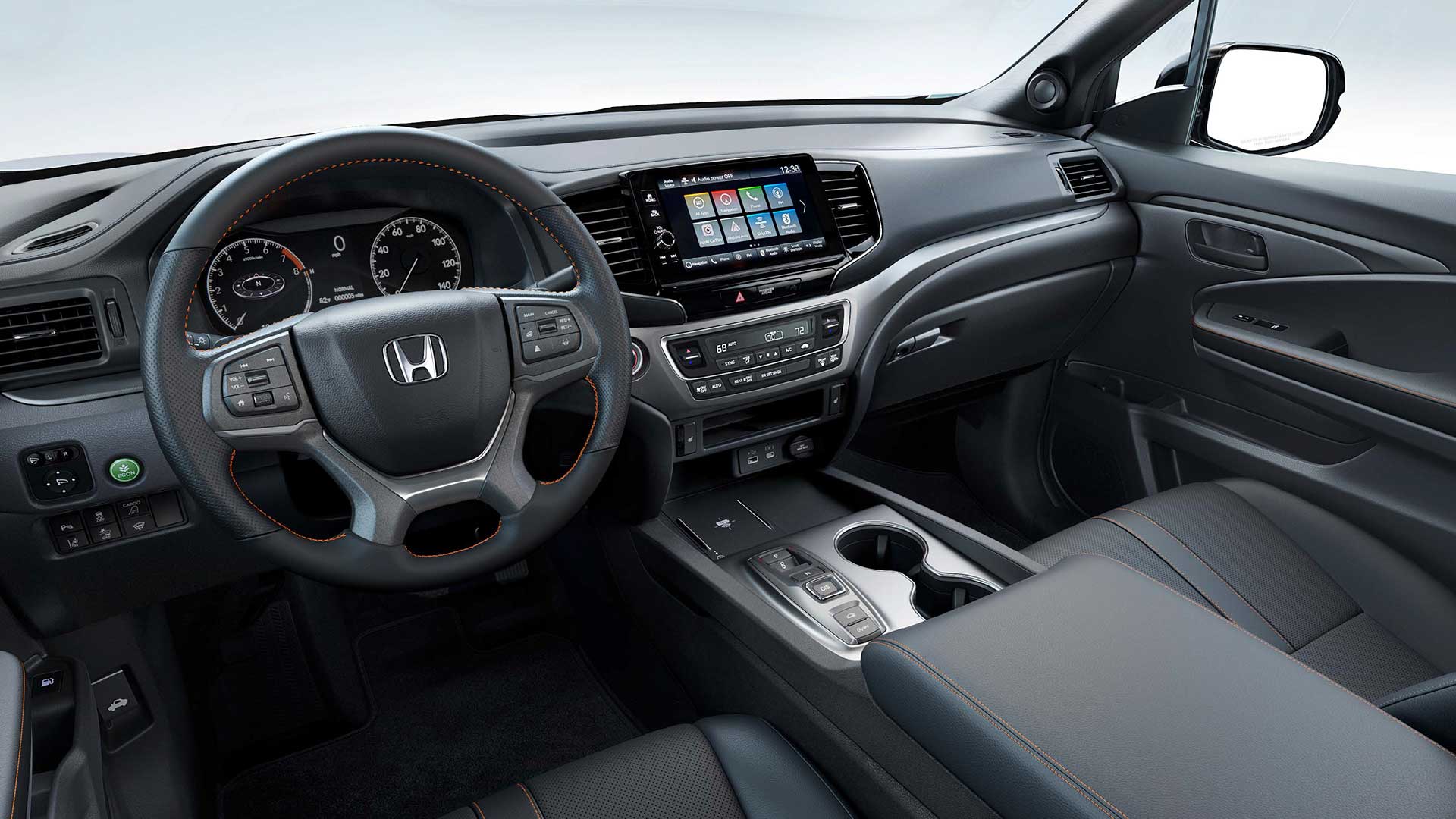
The revised suspension and knobbier tires didn’t really seem to add or detract from handling prowess, as it felt as solid, nimble, and car-like as it always has through our cone course. Perhaps a little less stiff than before, but good feedback, tight steering, and minimal body roll for a pickup, made for a very confidence inspiring experience. In our braking test, we stopped in a respectable average of 123 feet from 60, with only moderate amounts of nosedive and good feel through the pedal.
There is, however, a slight reduction in Government Fuel Economy Ratings with the all-terrain tires; 18-City, 23-Highway, and 20-Combined, our average, right on, at 20.4 mpg of Regular. That’s a slightly below average Energy Impact Score of 14.9 barrels of yearly oil use, with CO2 emissions of 7.4 tons.
TrailSport pricing falls in line just under the Ridgeline’s top Black Edition trim with a starting price of $46,375, about five grand over a base Ridgeline Sport.
So, whether you consider the Honda Ridgeline to be a “real” truck or not, this ruggedly smooth 2024 TrailSport does truck-like things better than ever. And we’re not just talking about the slight upgrade in off-road performance, we’re talking about a flexible bed to help you get chores done, and the ability to tow or haul with comfort and flexibility other trucks can only wish for. It’s why the Ridgeline brings more first-time buyers to Honda than any other vehicle, and why it continues to be a great choice in the growing midsize truck realm.
Specifications
- Engine: 3.5-liter V6
- Transmission: 9-speed automatic
- Horsepower: 280
- Torque: 262 lb-ft
- EPA: 18 City | 23 Highway | 20 Combined
- 0-60 mph: 7.0 seconds
- 1/4 Mile: 15.5 seconds at 90 mph
- 60-0 Braking (avg): 123 feet
- MW Fuel Economy: 20.4 mpg (Regular)
- Max Towing Capacity: 5,000-lbs





